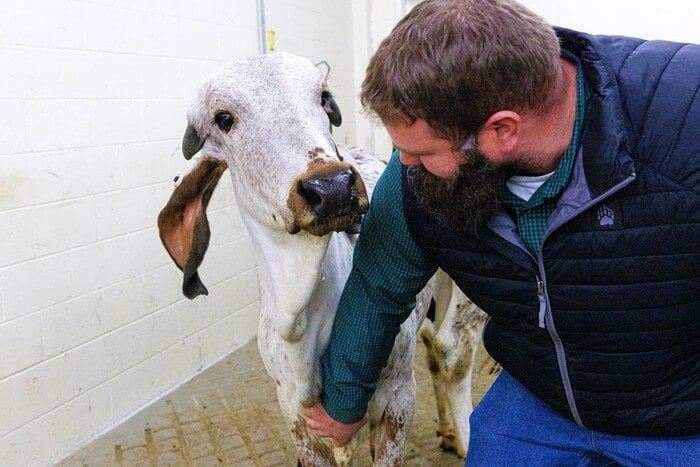- Scientists have found a way to make cows resistant to a virus called BVDV using gene editing.
- If successful, this technique could reduce the need for antibiotics and improve animal welfare.
- The gene-edited calf, named Ginger, was born healthy and resistant to the virus.
Scientists have found a way to make cows more resistant to a virus called bovine viral diarrhoea virus (BVDV). This virus can make cows very sick, especially if they are pregnant. Sometimes, infected cows give birth to calves that are also infected for their whole life. This can spread the virus to other cows.
“The most successful version of the future that I can see is one where we don’t have to deal with antimicrobial resistance because we just don’t use that many antimicrobials,” said veterinary epidemiologist Brian Vander Ley, an associate professor in the University of Nebraska-Lincoln’s School of Veterinary Medicine and Biomedical Sciences. “That’s better for everyone. That means that we have eliminated the cause of a lot of the antimicrobial use and we’ve eliminated that expense for livestock producers.”
The scientists changed the way the virus attaches to the cows’ cells using a special tool called gene editing. “Our objective was to use gene-editing technology to slightly alter CD46 so it wouldn’t bind the virus yet would retain all its normal bovine functions,” said Aspen Workman, a scientist with the USDA’s Agricultural Research Service (ARS) in Clay Center, Nebraska.
They tested this on cow cells in a lab, then used the same technique to make a calf that was resistant to the virus. “Our objective was to use gene-editing technology to slightly alter CD46 so it wouldn’t bind the virus yet would retain all its normal bovine functions,” said Aspen Workman.
The calf, called Ginger, was born healthy and did not get sick when she was put with a sick calf. This shows that the technique worked and could help cows stay healthy in the future.
If this technique works well, farmers might not need to use as many antibiotics or other medicines to keep their cows healthy. This is good news because too much medicine can be bad for the cows and for people who eat their meat. “This line of research represents another opportunity to lessen the need for antibiotics in agriculture,” said Michael Heaton, a researcher for the BVDV project.
The scientists are also thinking about whether this technique could be used to help other types of cows. “Follow-up research will require experimental replication in other cattle breeds,” said Workman.
This new discovery is exciting for the farmers who take care of cows, and for the people who eat their meat. However, we need to make sure we use this technique safely and wisely so that it helps the cows and doesn’t cause any harm.
FAQ
Q: Can humans get BVDV from eating meat?
A: No, BVDV does not affect humans, but it can be devastating for cows.
Q: Is gene editing safe for animals?
A: While gene editing holds great promise for improving animal health and welfare, it is important to continue studying its safety and efficacy.
Q: Will all cows be gene-edited in the future?
A: It is too soon to tell whether gene-edited cows will become widespread. More research is needed to ensure that this technology is safe and effective.
Q: How can I be sure the meat I’m eating is safe and healthy?
A: The U.S. Department of Agriculture (USDA) regulates meat production to ensure that it is safe and healthy for human consumption. Look for meat that has been inspected by the USDA.


